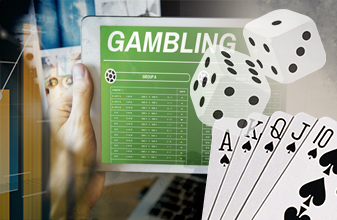Basic Math of Straight Sports Bets

Sharp Sports Betting is a tool for those interested in winning money at sports betting. The book explains the most common sports bets, what all the numbers mean, and the mathematics behind the numbers.
Let’s discuss some principles of sports betting. All sports bettors should learn the information below. All other kinds of casino advantage players, including blackjack players of all skill sets, which includes card counters, should also have a good working knowledge of Expected Value.
The purpose of this article is to explain the basic mathematical concepts used in sports betting.
Player’s Edge
When you put numbers on the player’s edge, you can call the result the win rate. Or you can call it your edge. Or you can call it return on investment or ROI. All those terms mean the same thing.
This and the following articles make extensive use of the word “terms.” The terms of a bet are the details of how much you win if you win and how much you lose if you lose.
If the amount you stand to win is less than the amount you stand to lose, the “terms” are expressed in terms of how many units you must risk to win 100 units.
If the amount you stand to win exceeds how much you stand to lose, the “terms” are how many units you will win if you wager 100 units.
That sounds confusing but is actually unambiguous and easy to understand in practice.
Bets at -110
The standard terms for betting sports in the legal sportsbooks of Nevada are -110. This is the default, the terms so widely used that they are widely understood to apply unless the book specifically specified other terms. If you see Chicago +3 for example, and want to bet on it, the assumption is that you will have to risk $110 for every $100 you want to win, unless the terms of the bet specifically say otherwise. If the bet is described as Chicago +3 -115, then you must risk $115 to win $100 on Chicago +3. But if the bet is described as simply Chicago +3, then everyone understands that to mean Chicago +3 -110.
-110 means you, the bettor, must risk $110 to win $100. The bet does not have to be exactly $110; the terms are merely stated in the form of how much you have to risk to win $100. You can wager $44 to win $40, $132 to win $120, etc.
When you make a bet, you give your money to the sportsbook, which holds onto your money and gives you a ticket as a receipt. The ticket explains all the details of the bet you have made, and if your bet wins you return that ticket to the sportsbook to collect your winnings.
If your ticket loses it becomes worthless, except as backup should the IRS audit your tax return.
If your ticket wins, and you have made a bet at -110, the amount you will get for your ticket is the amount you have wagered times 210/110. If you wagered $110, your winning ticket will be worth $210. If you wagered $11, your winning ticket will be worth $21. If you wagered $5, your winning ticket will be worth theoretically $9.54545, but the amount you actually will receive will be $9.50.
Here is a warning commonly found in a sportsbook’s posted list of rules for sports wagering:
“The sportsbook is not responsible for lost or stolen tickets.”
Until the game has been played and your team has lost, be as careful with your ticket as you would be with currency. If you lose your ticket and someone else finds it, you will have as difficult a time reclaiming your ticket as you would had you lost a $100 bill. Whoever finds it will probably cash it.
Vig at -110
This question was posted on BJ21.com: “I have a basic question. How does one calculate a break-even win rate, given the vig? I read somewhere that it’s 52.5 percent given the standard -110, but don’t know where it comes from. Thanks.”
Here is the way to figure it. You bet $110, and if your team wins you cash a ticket for $210. If your team loses, your ticket has no value. How often do you have to be right so that on average you will turn $110 into $210? Just divide 110 by 210. The answer is 52.38095 percent, which generally is rounded off to 52.38, 52.4, or 52.5 percent.
The sportsbook’s vig ideally is one bet out of 22, or 4.5 percent. Here’s how to get it. Suppose the sportsbook takes in $11 on one side and $11 on the other side. If one side wins the other side loses, and the book pays out $21 to the winner, keeping $1 for itself. The book’s profit is $1 no matter which side wins. $1 profit on $22 of bets is 1/22 or 4.5 percent.
I said “ideally” because the book makes 4.5 percent with an equal split of bets on both sides, but if there is more action on one side than the other, the book will win something different from 4.5 percent.
If the book makes a bad line and a majority of the money is bet by people who make a better line than the book, the book’s expectation might be to lose. Booking bets at -110 is no guarantee of winning unless either the line splits the action or the line is good enough so that even though more than 50% of the money is bet on one side, that side has only about a 50 percent chance of covering.
Terms Other Than -110 will be covered in a future article.
This is part of an occasional series of articles.
Excerpted with permission from Sharp Sports Betting by Stanford Wong, edited for this format.











Please log in or register to leave a comment